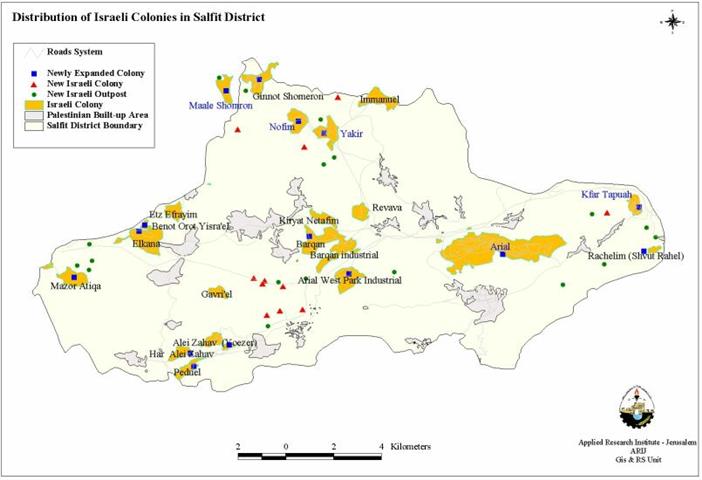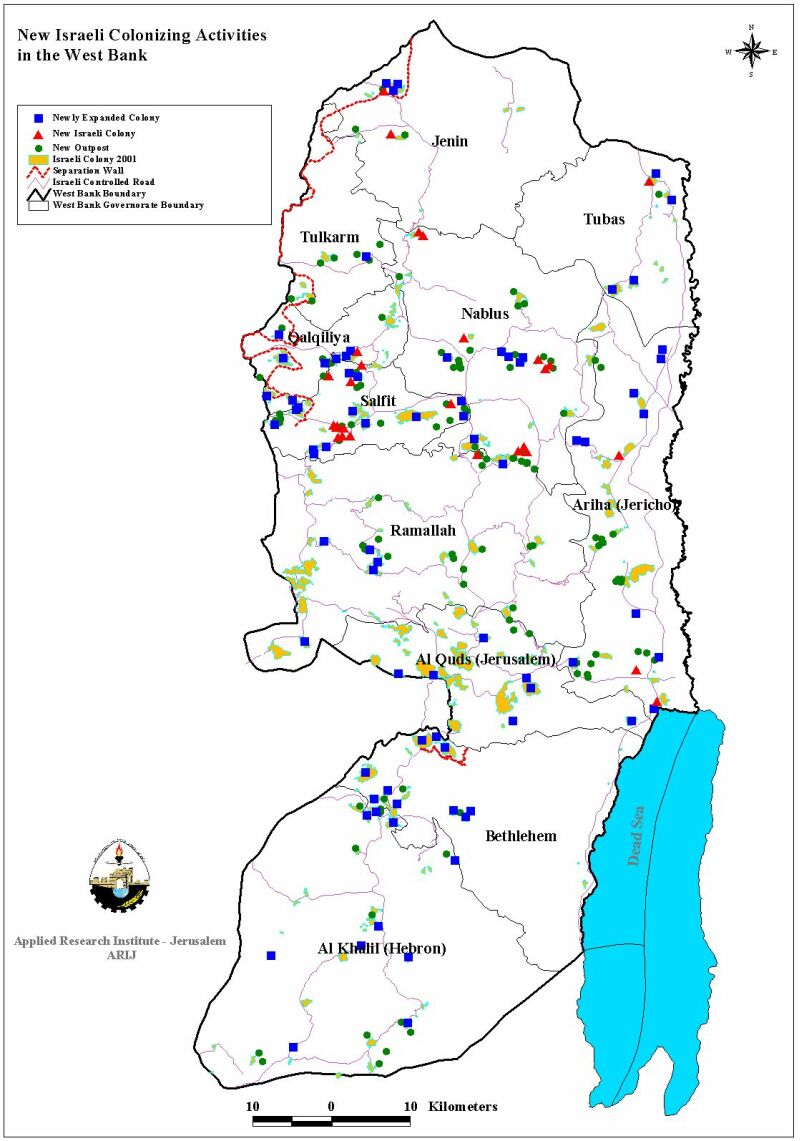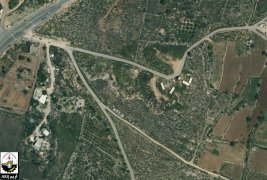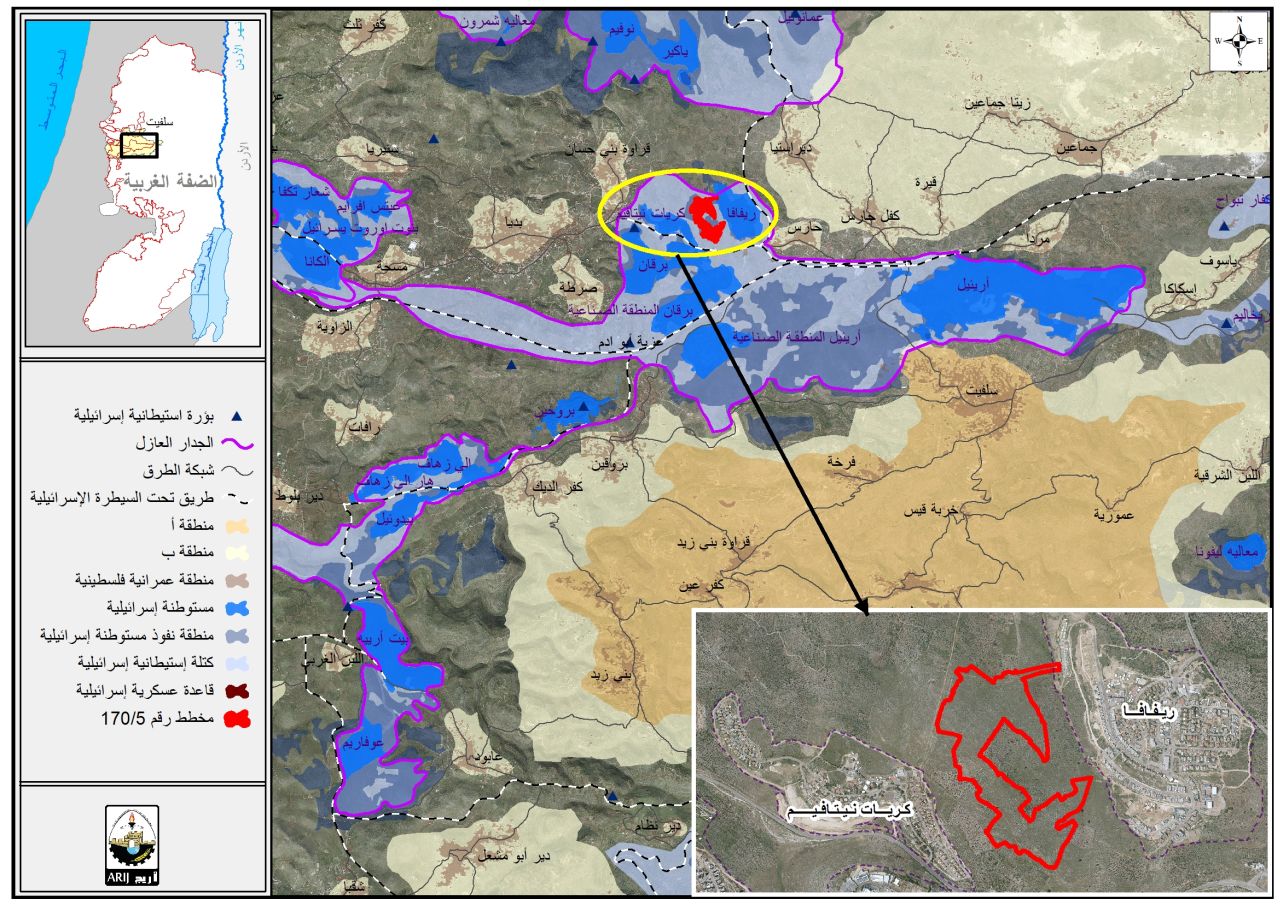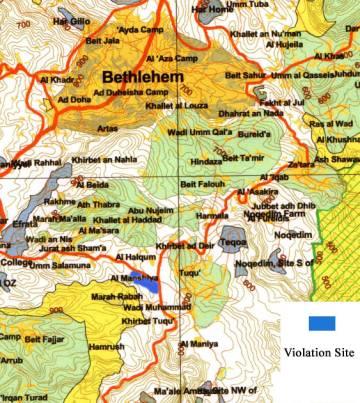By analyzing the satellite images through the help of the Geographic information System unit (GIS), ARIJ revealed that during the last year 2001-2002 there has been 24 newly constructed settlements, and 113 new outposts composed of several caravans to be transformed later on into settlements. In addition, the settlements that are found in the West Bank made a severe expansion that reached an area of 11128 dunums (11.128 Km2). The following table summarizes these activities in the districts of the West Bank:
Table 1
|
District |
Newly expanded Israeli settlements |
New Israeli settlements |
New outpost (caravans) |
||||
|
No. |
Area in 2001 / dunums |
Area in 2002 / dunums |
Area of expansion / dunums |
No. |
Area in dunums |
No. |
|
|
Jenin |
3 |
820 |
1290 |
241 |
1 |
14.7 |
3 |
|
Tubas |
4 |
3354 |
5386 |
2032 |
– |
– |
1 |
|
Tulkarm |
1 |
385 |
526 |
141 |
– |
– |
7 |
|
Qalqilya |
7 |
3751 |
7.66 |
3315 |
1 |
36 |
5 |
|
Salfit |
14 |
11435 |
14415 |
2980 |
11 |
933 |
17 |
|
Nablus |
6 |
3888 |
4770 |
882 |
8 |
362.6 |
22 |
|
Jericho |
10 |
3615 |
4923 |
1308 |
3 |
422.3 |
20 |
|
Ramallah |
– |
– |
20 |
||||
|
Jerusalem |
– |
– |
2 |
||||
|
Bethlehem |
– |
– |
5 |
||||
|
Hebron |
– |
– |
11 |
||||
|
Total |
45 |
27248 |
38376 |
11128 |
24 |
27248 |
38376 |
Source: ARIJ-GIS-Database- 2001/2002
The Israeli colonizing activities seems to be at maximum in the district of Salfit, where as we can observe from table 1 that there are 11 new settlements having an area of 933 dunums and 17 new outposts in that district. The total expansion of Israeli settlements reached 2980 dunums. The majority of new settlements are concentrated around the old ones, such as those located to the west and to the southwest of Arial Settlement, south of Maale Shomron settlement, south of Nofim settlement, northeast of Yakir settlement and east of Kfar tapuah. See Map1
The district of Nablus is becoming in the second place according to the number of new settlements, which is 8 with an area of 363 dunums. But, the district of Nablus is having the highest number of new outposts that is 22.
Jericho district is located third, by having 3 new settlements with an area of 422 dunums and having 20 new outposts. The total expansion in the district reached an area of 1308 dunums.
Qalqilya district is having the highest number of area expanded of the new settlements which is 3315 dunums and 5 new outposts, in addition the Israelis are planning to build a new settlement in the same district.
In total, ARIJ research unit found that the 45 Israeli settlements that are under going massive expansion with an area of 11128dunums, while 24 settlements among these are new and the number of new outposts is 113 spread in the West Bank. See Map2
The Israeli government announced that it had dismantled 2 outposts in the region of Gush Talmonim west of Ramallah, and that there are 3 new settlements which are inhabited by new settlers which are: Hifat Gila'ad , Giv'at Assaf and Assaf Heirshkofitsh among the 24 new settlements. But in reality this is ridiculous, because the Israeli government declare dismantling 2 small outposts while they are building and expanding other settlements opposing to the Mitchel report.
As we can see in the map, the majority of expansions, new settlements and outposts are concentrated in the districts of Salfit, Nablus, Qalqilya, Jericho, Tubas and Ramallah. This plan goes with the aim of the Israeli government, which is to open corridors connecting the Israeli settlements located to the east of the green line with settlements found in the Jordan valley, in addition to the plan of separation wall that the Israeli government is trying to apply along the green line and the surrounding of Jerusalem. The application of this plan includes opening of bypass roads and uprooting of thousands of bearing trees.
By that, the Israeli government is little by little isolating the Palestinian residential areas, cutting its geographical contiguity and limiting its future expansion. Also, this colonial attack is costing the Palestinians a lot of their agricultural land while the eyes of the world are all pointed at the Iraqi problem. So, the Israeli government is trying to benefit from actual international political circumstances to swallow more Palestinian lands and aborting any future chances to create peace in the region by making the Israeli-Palestinian issue more complicated.
Prepared by:
The Applied Research Institute – Jerusalem


